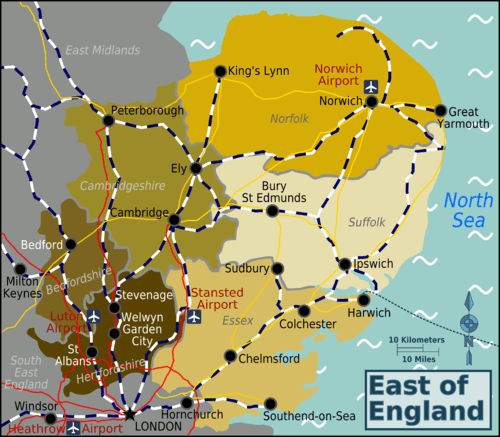East of England
The East of England is the most easterly region of England and indeed of the whole United Kingdom. It lies broadly to the north of London, the Thames estuary and South East England, to the south of the Wash (the square shaped indentation on England's east coast) and to the east of the East Midlands. The most easterly parts of this region are known as "East Anglia", which at its strictest definition only includes Norfolk and Suffolk but often includes all or part of Cambridgeshire and at its loosest definition covers the entire East of England.
Counties
The East of England is a largely flat region consisting of the following counties:

| Bedfordshire home of charming Woburn and multicultural Luton |
| Cambridgeshire most visitors come to see Cambridge's university, but cathedral city Ely in the Fens shouldn't be overlooked |
| Essex hosts the world's longest pleasure pier in Southend and Britain's oldest recorded town, Colchester |
| Hertfordshire St Albans, a satellite of London since Roman times |
| Norfolk historic Norwich and lively Great Yarmouth provide access to pastoral lands with scenic windmills in the Broads |
| Suffolk has 21st century Gothic revivalist architecture in Bury St Edmunds and Britain's most easterly point in Lowestoft |
Towns and cities
Listed below are ten cities and towns of greatest interest to travellers:
Cities
Other destinations
- The Broads
- The Sunrise Coast
- 🌍 Weald Country Park
- 🌍 Minsmere Nature Reserve
- 🌍 Sutton Hoo
Understand
The East of England is historically a rural region of small capitals, market towns and picturesque villages. The character of the flattish landscape has been heavily influenced by the people that live on it - most notably with the draining of the Fens transforming marshland into fertile farmland, and the ancient excavations that resulted in the waterways of Norfolk's Broads.
Proximity to the capital city and good farming has long made the region relatively prosperous, and much of the southern area of the region now serves as a base for commuters to London. The effect of this London overspill has been the rapid growth of suburban housing in the regions towns and the construction of purpose-built "New Towns" such as Letchworth, Welwyn Garden City, and Stevenage.
Talk
The East of England is an English-speaking region, and travellers should have little difficulty in understanding locals, who generally speak in an accent similar to that of London and most of South Eastern England. The exception to this is East Anglia, in which a strong local dialect persists.
Get in
By plane
The region contains two of the UK's top five busiest airports: London Stansted (in Essex) and Luton Airport (in Bedfordshire). There is also Norwich International Airport. These airports mainly serve domestic and European flights but there are also a smattering of departures to the Middle East, North Africa and Chicago. If travelling from further afield, London Heathrow is your best bet and should be no more than 2 hours and 30 minutes' drive from anywhere in the region.
By sea
Harwich International Port - scheduled ferries are operated by Stena Line to Rotterdam and Hook of Holland in The Netherlands and by DFDS Tor Line to Esbjerg in Denmark. Some cruise ships also dock in Harwich.
By train
The main railway lines radiate north from London: the Great Eastern Line links Colchester, Ipswich and Norwich, the major East Coast Line passes through Stevenage and Peterborough en route to Scotland and the Midland Main Line runs through St Albans, Luton (for the airport) and Bedford to Yorkshire. There is also a smaller line from London to Cambridge via Stansted Airport. Routes heading west are more limited and pass via Peterborough.
By bus
Long distance bus services connect the region's major centres of population, although the often busy road network makes them a slower option.
Get around
By train
The region is well served by rail services in a North/South direction, less so in an East/West direction.
By bus
Rural bus services operate in most parts of the region, and tend to offer good service. National Express offer infrequent long distance coach services.
By car
The region's road network is generally in a good condition and relatively traffic free in most areas, though what appears to be a major trunk route on a map often turns out to be a windy rural road passing through villages.
By boat
For a slower pace, it's possible to hire boats to take on the region's waterways. Travelling by boat is by far the best way of experiencing the Broads.
See
Do
Eat
Drink
Stay safe
The East of England is a prosperous and predominantly rural region presenting relatively few hazards to the traveller, but a little common sense can go a long way. See the England page for more general safety tips in England
Drivers should be careful on the region's roads, which often have deceptively sharp corners and are flanked by deep, unfenced drainage ditches.
Go next
- Take a train to enjoy the faster pace of life and greater cultural diversity of London.
- Mediaeval Lincoln and Robin Hood's old haunt Sherwood Forest are just a short hop away in the East Midlands.